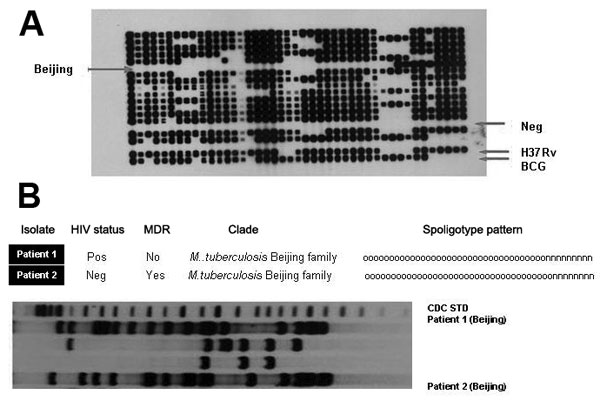Volume 16, Number 2—February 2010
Letter
Mycobacterium tuberculosis Beijing Strain, Bamako, Mali
Appendix Figure

Appendix Figure. A) Identification of isolates of the Mycobacterium tuberculosis Beijing clade (6) by using spoligotyping. The spoligotype pattern of the M. tuberculosis Beijing clade is characterized by the absence of hybridization of spacers 1–34 as shown, in combination with hybridization of spacers 35–43. Negative control (Neg.) shows absence of all spacers. For comparison, H37Rv (a laboratory strain) and M. bovis BCG show different patterns of spacers. Also shown are other clades not identified. B) Restriction fragment length polymorphism (7) patterns of strains from the 2 patients. Patterns confirm that both strains belong to the Beijing clade. However, patterns indicate different strains and confirm lack of direct transmission between the patients. The 2 additional clades shown (not from these patients) illustrate differences between the Beijing and other clades.
References
- Filliol I, Driscoll JR, van Soolingen D, Kreiswirth BN, Kremer K, Valétudie G, Global distribution of Mycobacterium tuberculosis spoligotypes. Emerg Infect Dis. 2002;8:1347–9.PubMedGoogle Scholar
- European Concerted Action on New Generation Genetic Markers and Techniques for the Epidemiology and Control of Tuberculosis. Beijing/W genotype Mycobacterium tuberculosis and drug resistance. Emerg Infect Dis. 2006;12:736–43.PubMedGoogle Scholar
- van Soolingen D, Qian L, de Haas PE, Douglas JT, Traore H, Portaels F, Predominance of a single genotype of Mycobacterium tuberculosis in countries of east Asia. J Clin Microbiol. 1995;33:3234–8.PubMedGoogle Scholar
- Glynn JR, Whiteley J, Bifani PJ, Kremer K, van Soolingen D. Worldwide occurrence of Beijing/W strains of Mycobacterium tuberculosis: a systematic review. Emerg Infect Dis. 2002;8:843–9.PubMedGoogle Scholar
- Bifani PJ, Mathema B, Kurepina NE, Kreiswirth BN. Global dissemination of the Mycobacterium tuberculosis W-Beijing family strains [review]. Trends Microbiol. 2002;10:45–52. DOIPubMedGoogle Scholar
- Kremer K, Glynn JR, Lillebaek T, Niemann S, Kurepina NE, Kreiswirth BN, Definition of the Beijing/W lineage of Mycobacterium tuberculosis on the basis of genetic markers. J Clin Microbiol. 2004;42:4040–9. DOIPubMedGoogle Scholar
- Van Embden JD, Cave MD, Crawford JT, Dale JW, Eisenach KD, Gicquel B, Strain identification of Mycobacterium tuberculosis by DNA fingerprinting: recommendations for a standardized methodology. J Clin Microbiol. 1993;31:406–9.PubMedGoogle Scholar
- van der Spuy GD, Kremer K, Ndabambi SL, Beyers N, Dunbar R, Marais BJ, Changing Mycobacterium tuberculosis population highlights clade-specific pathogenic characteristics. Tuberculosis (Edinb). 2009;89:120–5. Epub 2008 Dec 2. DOIPubMedGoogle Scholar
- Werngren J, Hoffner SE. Drug-susceptible Mycobacterium tuberculosis Beijing genotype does not develop mutation-conferred resistance to rifampin at an elevated rate. J Clin Microbiol. 2003;41:1520–4. DOIPubMedGoogle Scholar
- Cowley D, Govender D, February B, Wolfe M, Steyn L, Evans J, Recent and rapid emergence of W-Beijing strains of Mycobacterium tuberculosis in Cape Town, South Africa. Clin Infect Dis. 2008;47:1252–9. DOIPubMedGoogle Scholar